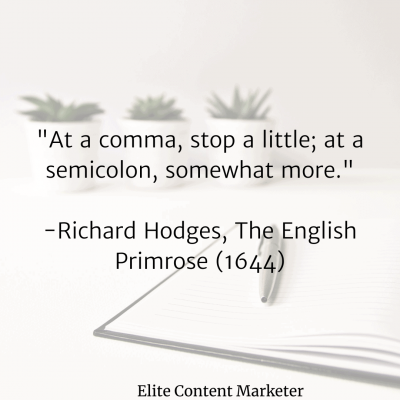What do you get when a period climbs over a comma?
You get half a winky face, or as it is known more formally the semicolon ( ; ).
This punctuation mark has a history of being used where it doesn’t belong. Other times, people will replace it with a comma and end up with a grammatically incorrect sentence. (You can almost hear the ; mocking you with its wink).
Let’s explore three places where you should use the semicolon, followed by a list of four common mistakes that people often make while using it. You’ll know when and how to use this punctuation mark once you’re done reading this article.
Recommended reading: Affect Or Effect: How To Get The Right Word Every Time
Three Places That Warrant Semicolon Usage
Here are three instances when you’ll need to call the services of the semicolon.

1. Connect Two Independent Clauses
Independent clauses are clauses that can stand alone as separate sentences. If you want to connect two related independent clauses (that also share a logical connection), then you can use a semicolon.
Example: Jack has gone to buy tools; he needs to repair the sink.
Note that the two sentences can be separated by a period and still make sense. A semicolon simply lays the emphasis on the connection between the two clauses.
Here’s another example from Anna Karenina by Leo Tolstoy:
Happy families are all alike; every unhappy family is unhappy in its own way.
To understand it better here’s a video shared by Khan Academy’s Paige, a junior at UC Berkeley majoring in linguistics:
2. Create A List With Internal Commas
Semicolons can also be used to divide lists that have a lot of items or internal punctuation. Here the semicolon becomes your “super-comma” that helps you keep track of the division between various items.
Example: The new mall will have grocery stores on the first floor; movies and clothing apparel on the second floor; and food court on the third floor.
Here’s a slightly more complex example of semicolons in a list inside Bleak Houses: by Charles Dickens:
I found it quite a delightful place – in front, the pretty avenue and drive by which we had approached (and where, by and by, we had cut up the gravel so terribly with our wheels that I asked the gardener to roll it); at the back, the flower-garden, with my darling at her window up there, throwing it open to smile out at me, as if she would have kissed me from that distance. Beyond the flower-garden was a kitchen-garden, and then a paddock, and then a snug little rick-yard, and then a dear farm-yard. As to the house itself, with its three peaks in the roof; its various-shaped windows, some so large, some so small, and all so pretty; its trellis-work, against the south-front for roses and honey-suckle, and its homely, comfortable, welcoming look – it was, as Ada said when she came out to meet me with her arm through that of its master, worthy of her cousin John, a bold thing to say, though he only pinched her dear cheek for it.
3. Linking Independent Clauses By Transitional Phrases Or Conjunctive Adverbs
When you want to connect two related independent clauses by a transitional phrase or conjunctive adverbs, it could use a semicolon. As with the first rule we discussed, both the clauses should make complete sense as standalone sentences too.
These types of phrases/adverbs include words such as nevertheless, consequently, accordingly, finally, indeed, etc — these words can also be used in other parts of the sentence.
Example: Reports of the economic crises were greatly overestimated; indeed, the crisis wasn’t so bad after all.
Next up, you’ll learn the common mistakes people make when using the semicolon. But if you want a quick summary of everything that we’ve learned until now, then you can watch the TED-Ed lesson on semicolons by Emma Bryce below:
Four Common Semicolon Mistakes You Need To Avoid
A semicolon can either be your best friend for coherent writing or your worst grammatical mistake. Avoid making these common mistakes to stay friends with this punctuation mark.
1. Using Conjunction And A Semicolon
Conjunctions (example: and, but, or) can be used to connect two related independent clauses. Semicolons can also be used for the same.
But:
You can’t use both the conjunction and the semicolon to connect two independent clauses at the same time.
So for example,
- She saw a glorious concert; and she went with her friends.
- She saw a glorious concert, and she went with her friends.
- She saw a glorious concert; she went with her friends.
2. Using A Capital Letter After The Semicolon
A semicolon should be followed by a capital letter only if the word is an acronym or a proper noun. In all other cases, the capital letter shouldn’t be used.
- Some artists prefer pen and paper; Others prefer computer notes.
- Some artists prefer pen and paper; Morrie prefers computer notes.
Since Morrie is a proper noun, the first letter would be capitalized. But in the first sentence, others is a common noun, and wouldn’t be capitalized.
3. Using A Comma Instead Of A Semicolon
A comma splice is one of the most common grammatical blunders in the usage of commas and semicolons. It occurs when you use a comma in a sentence that calls for the usage of a semicolon. Here’s an example:
- He is witty, he is also patient.
- He is witty; he is also patient.
Remember semicolons connect two independent clauses. Commas should never be used when you want to connect two independent clauses without a conjunction.
- I am thinking of dropping physics, I don’t enjoy it.
- I am thinking of dropping physics; I don’t enjoy it.
- I am thinking of dropping physics because I don’t enjoy it.
4. Using A Semicolon Instead Of A Comma
Much like in the case of a comma, you never use a semicolon to connect two dependent clauses. If you want to connect two dependent clauses, use a comma.
- Because she is full; she won’t eat anymore.
- Because she is full, she won’t eat anymore.
Since the first part of the sentence is not an independent clause, a semicolon is not required. It’s used only when both the sentences are independent clauses.
- The publication required an APA formatted reference list; which it did not have.
- The publication required an APA formatted reference list, which it did not have.
Here, as you can notice, the first and second part of the sentence are dependent clauses. Hence, a comma is required and not a semicolon.
Conclusion
A semicolon is a good punctuation mark to write coherently. Whether you want to add some humor to the situation or knead a complicated sentence, now you know how to use that half-winky face to your benefit 😉
Why not read some writing tips to polish your craft up next?
